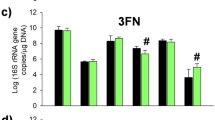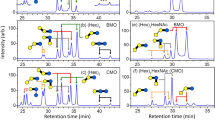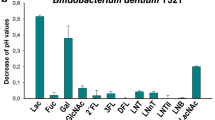Abstract
Objectives:
Human colostrum is known to be important for the protection of infants against infection by pathogenic microorganisms. This protection is thought to be due, partially, to various neutral and acidic oligosaccharides that are present in colostrum and milk. However, the concentrations of each of the oligosaccharide of human colostrum have not yet been determined. The aim of this present study was to determine the concentration of each of the major neutral oligosaccharide for three consecutive days from the start of lactation.
Method:
We analyzed the level of each neutral oligosaccharide in human colostrum, for three consecutive days from the start of lactation, obtained from 12 healthy Japanese women (ranging in age from 21 to 35 years; primipara 6 and multipara 6). The ABO blood groups of the donors were determined: A, three; B, three; O, five; AB, one. The determined human milk oligosaccharides were 2′-fucosyllactose (2′-FL), 3-fucosyllactose (3-FL), lactodifucotetraose (LDFT), lacto-N-tetraose (LNT), lacto-N-neotetraose (LNnT), three lacto-N-fucopentaose (LNFP I, II and III) and two lacto-N-difucohexaose (LNFDH I and II) using high-performance liquid chromatography (HPLC) with two derivatization techniques.
Results:
The concentrations of 2′-FL and LDFT in colostrum on day 1 were significantly higher than those on days 2 and 3 (P<0.05). An increase in LNT was observed on day 3 compared with day 1 (P<0.05).
Conclusion:
These changes in concentrations of 2’-FL, LDFT and LNT may reflect the requirements for prebiotics and anti-infection agents by human infants during early lactation.
This is a preview of subscription content, access via your institution
Access options
Subscribe to this journal
Receive 12 print issues and online access
$259.00 per year
only $21.58 per issue
Buy this article
- Purchase on Springer Link
- Instant access to full article PDF
Prices may be subject to local taxes which are calculated during checkout




Similar content being viewed by others
References
Benno Y, Suzuki K, Suzuki K, Narisawa K, Bruce WR, Mitsuoka T (1986). Comparison of the fecal microflora in rural Japanese and urban Canadians. Microbiol Immunol 30, 521–532.
Chaturvedi P, Warren CD, Altaye M, Morrow AL, Ruiz-Palacios G, Pickering LK et al. (2001). Fucosylated human milk oligosaccharides vary between individuals and over the course of lactation. Glycobiology 11, 365–372.
Chaturvedi P, Warren CD, Ruiz-Palacios G, Pickering LK, Newburg DS (1997). Milk oligosaccharide profiles by reversed-phase HPLC of their perbenzoylated derivatives. Anal Biochem 251, 89–97.
Cleary TG, Chambers JP, Pickering LK (1983). Protection of suckling mice from the heat-stable enterotoxin of Escherichia coli by human milk. J Infect Dis 148, 1114–1119.
Coppa GV, Bruni S, Morelli L, Soldi S, Gabrielli O (2004). The first prebiotics in human: human milk oligosaccharides. J Clin Gastroenterol 38, S80–S83.
Coppa GV, Pierani P, Zampini L, Carloni I, Carlucci A, Gabrielli O (1999). Oligosaccharides in human milk during different phases of lactation. Acta Paediatr Suppl 430, 89–94.
Coppa GV, Zampini L, Galeazzi T, Facinelli B, Ferrante L, Capretti R et al. (2006). Human milk oligosaccharides inhibit the adhesion to Caco-2 cells of diarrheal pathogens: Escherichia coli, Vibrio cholerae, and Salmonella fyris. Pediatr Res 59, 377–382.
Dai D, Nanthkumar NN, Newburg DS, Walker WA (2000). Role of oligosaccharides and glycoconjugates in intestinal host defense. J Pediatr Gastroenterol Nutr 30, S23–S33.
Gnoth MJ, Kunz C, Kinne-Saffran E, Rundloff S (2000). Human milk oligosaccharides are minimally digested in vitro. J Nutr 130, 3014–3020.
Grollman AP, Hall CW, Ginsburg V (1965). Biosynthesis of fucosyllactose and other oligosaccharides found in milk. J Biol Chem 240, 975–981.
Honda S, Akao E, Suzuki S, Okuda M, Kakehi K, Nakamura J (1989). High-performance liquid chromatography of reducing carbohydrates as strongly ultraviolet-absorbing and electrochemically sensitive 1-phenyl-3-methyl-5-pyrazolone derivatives. Anal Biochem 180, 351–357.
Katayama T, Sakuma A, Kimura T, Makimura Y, Hiratake J, Sakata K et al. (2004). Molecular cloning and characterization of Bifidobacterium bifidum 1,2-alpha-L-fucosidase (AfcA), a novel inverting glycosidase (glycoside hydrolase family 95). J Bacteriol 186, 4885–4893.
Kitaoka M, Tian J, Nishimoto M (2005). Novel putative galactose operon involving lacto-N-biose phosphorylase in Bifidobacterium longum. Appl Environ Microbiol 71, 3158–3162.
Kobata A, Yamashita K, Tachibana Y (1978). Oligosaccharides from human milk. Methods Enzymol 50, 216–220.
Kunz C, Rodriguez-Palmero GM, Koletzko B, Jensen R (1999). Nutritional and biochemical properties of human milk, Part I: General aspects, proteins, and carbohydrates. Clin Perinatol 26, 307–333.
Kunz C, Rudloff S, Baier W, Klein N, Strobel S (2000). Oligosaccharides in human milk: structural, functional, and metabolic aspects. Annu Rev Nutr 20, 699–722.
Morrow AL, Ruiz-palacios GM, Altaye M, Jiang X, Guerrero ML, Meinzen-Derr JK et al. (2004). Human milk oligosaccharide blood group epitopes and innate immune protection against campylobacter and calicivirus diarrhea in breastfed infants. Adv Exp Med Biol 554, 443–446.
Morrow AL, Ruiz-Palacios GM, Jiang X, Newburg DS (2005). Human-milk glycans that inhibit pathogen binding protect breast-feeding infants against infectious diarrhea. J Nutr 135, 1304–1307.
Musumeci M, Simpore J, D’Agata A, Sotgiu S, Musumeci S (2006). Oligosaccharides in colostrum of Italian and Burkinabe women. J Pediatr Gastroenterol Nutr 43, 372–378.
Nakamura T, Urashima T, Nakagawa M, Saito T (1998). Sialyllactose occurs as free lactones in ovine colostrum. Biochim Biophys Acta 1381, 286–292.
Newburg DS (1996). Oligosaccharides and glycoconjugates in human milk: their role in host defense. J Mammary Gland Biol Neoplasia 1, 271–283.
Newburg DS (1997). Do the binding properties of oligosaccharides in milk protect human infants from gastrointestinal bacteria? J Nutr 127, 980–984.
Newburg DS, Neubauer SH (1995). Carbohydrates in milks: analysis, quantities, and significance. In: Handbook of Milk Composition, ed. Jensen RG, Academic Press: San Diego. pp 273–349.
Newburg DS, Pickering LK, McCluer RH, Cleary TG (1990). Fucosylated oligosaccharides of human milk protect suckling mice from heat-stabile enterotoxin of Escherichia coli. J Infect Dis 162, 1075–1080.
Ogra PL, Ogra SS (1988). Cellular aspects of immunologic reactivity in human milk. In: Biology of Human Milk, ed. Hanson LA, Nestle Nutr Workshop Series vol 15. pp 171–184. Raven Press: New York.
Oriol R, Mollicone R, Cailleau A, Balanzino L, Breton C (1999). Divergent evolution of fucosyltransferase genes from vertebrates, invertebrates, and bacteria. Glycobiology 9, 323–334.
Rotimi VO, Duerden BI (1981). The development of the bacterial flora in normal neonates. J Med Microbiol 14, 51–62.
Ruiz-Palacios GM, Cervantes LE, Ramos P, Chavez-Munguia B, Newburg DS (2003). Campylobacter jejuni binds intestinal H(O) antigen (Fuc alpha 1, 2Gal beta 1,4GlcNAc), and fucosyloligosaccharides of human milk inhibit its binding and infection. J Biol Chem 278, 14112–14120.
Sumiyoshi W, Urashima T, Nakamura T, Arai I, Nagasawa T, Saito T et al. (2003a). Sialyl oligosaccharides in the milk of Japanese women: change in concentration during the course of lactation. J Appl Glycosci 50, 461–467.
Sumiyoshi W, Urashima T, Nakamura T, Arai I, Saito T, Tsumura TN et al. (2003b). Determination of each neutral oligosaccharide in the milk of Japanese women during the course of lactation. Br J Nutr 89, 61–69.
Takemoto H, Hase S, Ikenaka T (1985). Microquantitative analysis of neutral and amino sugars as fluorescent pyridylamino derivatives by high-performance liquid chromatography. Anal Biochem 145, 245–250.
Thurl S, Henker J, Siegel M, Tovar K, Sawatzki G (1997). Detection of four human milk groups with respect to Lewis blood group dependent oligosaccharides. Glycoconj J 14, 795–799.
Thurl S, Muller-Werner B, Sawatzki G (1996). Quantification of individual oligosaccharide compounds from human milk using high-pH anion-exchange chromatography. Anal Biochem 235, 202–206.
Veh RW, Michalski JC, Corfield AP, Sander-Wewer M, Gies D, Schauer R (1981). New chromatographic system for the rapid analysis and preparation of colostrums sialyloligosaccharides. J Chromatogr 212, 313–322.
Ward RE, Ninonuevo M, Mills DA, Lebrilla CB, German JB (2006). In vitro fermentation of breast milk oligosaccharides by Bifidobacteriuminfantis and Lactobacillus gasseri. Appl Environ Microbiol 72, 4497–4499.
Yoshioka H, Iseki K, Fujita K (1983). Development and differences of intestinal flora in the neonatal period in breast-fed and bottle-fed infants. Pediatrics 72, 317–321.
Acknowledgements
We thank Dr T Tominaga, the head of Obihiro Daiichi Hospital, for supervising the collection of human colostrum. We thank Mr Fiame Leo of our laboratory for kind advice. This study was supported by a grant from the 21st Century COE Program (A-1), Ministry of Education, Culture, Sports, Science, and Technology, Japan, and a grant-in-Aid from the Bio-oriented Technology Research Advancement Institution of the National Agriculture and Food Research Organization (Research and Development Program for New Bio-industry Initiatives, Japan).
Author information
Authors and Affiliations
Corresponding author
Additional information
Guarantors: S Asakuma and T Urashima. Contributors: SA and TU participated in study design, performed most of the statistical analysis and drafted the manuscript. All authors participated in data collection and interpretation, and reviewing the manuscript.
Rights and permissions
About this article
Cite this article
Asakuma, S., Urashima, T., Akahori, M. et al. Variation of major neutral oligosaccharides levels in human colostrum. Eur J Clin Nutr 62, 488–494 (2008). https://doi.org/10.1038/sj.ejcn.1602738
Received:
Revised:
Accepted:
Published:
Issue Date:
DOI: https://doi.org/10.1038/sj.ejcn.1602738
Keywords
This article is cited by
-
Using Organoids to Tap Mammary Gland Diversity for Novel Insight
Journal of Mammary Gland Biology and Neoplasia (2024)
-
Real-world evidence study on tolerance and growth in infants fed an infant formula with two human milk oligosaccharides vs mixed fed and exclusively breastfed infants
Molecular and Cellular Pediatrics (2023)
-
Creation of a milk oligosaccharide database, MilkOligoDB, reveals common structural motifs and extensive diversity across mammals
Scientific Reports (2023)
-
Bifidobacterium breve UCC2003 metabolises the human milk oligosaccharides lacto-N-tetraose and lacto-N-neo-tetraose through overlapping, yet distinct pathways
Scientific Reports (2016)
-
Characterization of bacterial populations from Murciano-Granadina goat colostrum
Dairy Science & Technology (2014)



